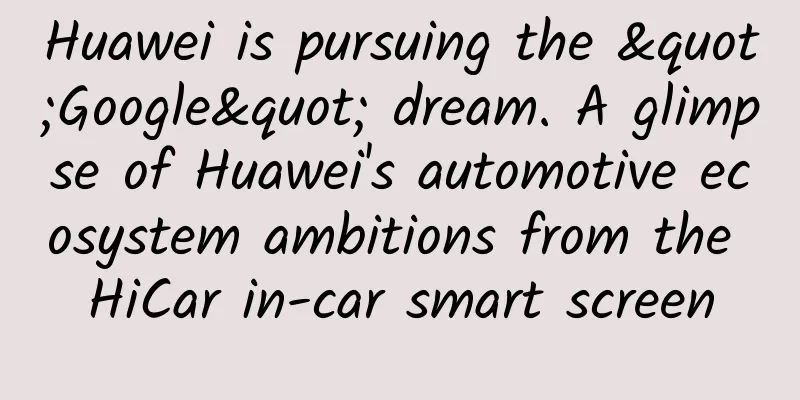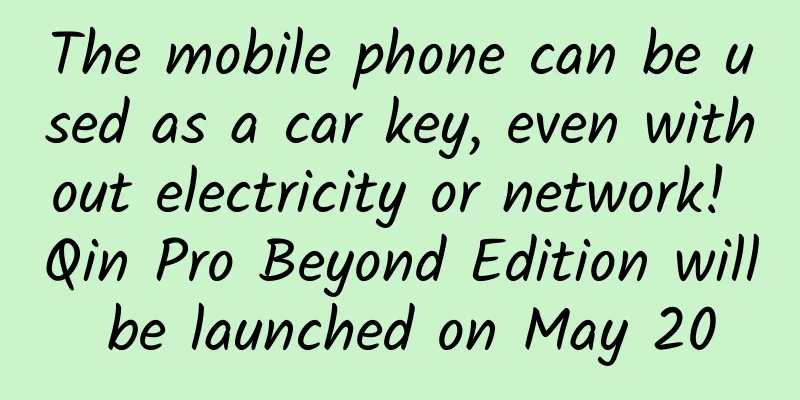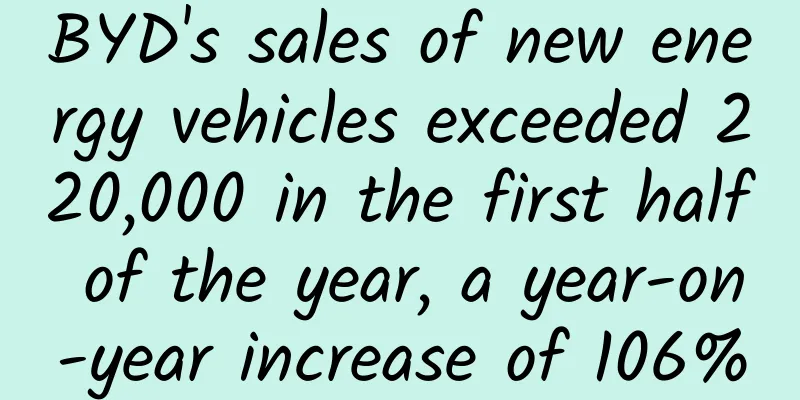Huawei is pursuing the "Google" dream. A glimpse of Huawei's automotive ecosystem ambitions from the HiCar in-car smart screen

|
While many domestic automakers are determined to become the "Huawei of the automotive industry", Huawei itself has firmly stepped into the automotive field. However, at a time when the concept of new energy vehicles is popular in the capital market, Huawei's goal is very clear: "not to build cars." Instead, it proposed an intelligent car solution with intelligent driving, intelligent cockpit, intelligent networking, intelligent electric, and intelligent car cloud as the core, and entered the trillion-dollar trend of autonomous driving as a software and hardware supplier. As the second only to mobile phones in Huawei's "1+8+N" strategy, automobiles, positioned as the "third space", have become the top priority in Huawei's full-scenario smart life strategy. HUAWEI HiCar is built by Huawei as the center of the automotive ecosystem and has become one of the most promising solutions in the field of Internet of Vehicles. However, although Huawei has long announced that HUAWEI HiCar's ecological partners include more than 30 car companies, including more than 150 models, because it takes a relatively long process from design and verification to official launch, the number of models currently installed with HUAWEI HiCar on the market is actually not very rich. Of course, due to the excellent user experience and the huge market share of Huawei mobile phones, users' demand for HUAWEI HiCar is real, and there are also many third-party car accessories on the market that support HUAWEI HiCar. Perhaps in order to ensure the stable experience of the HUAWEI HiCar system, allow some models with relatively backward car systems to experience the charm of HUAWEI HiCar and connect to the Huawei automotive ecosystem, Huawei did not officially launch the Huawei In-Car Smart Screen until the release of Mate 40. As an after-installed car central control system, Huawei's in-car smart screen opens the door to Huawei's smart life ecosystem for various car models. So, how is the installation effect of this product? Can it reflect Huawei's ambition in its first attempt in the automotive industry? Large screen + high pixel, new idea for aftermarket car machine Since it is called Huawei's "Smart Selection", this in-car smart screen is naturally an ecological chain product under Huawei. It is reportedly manufactured by the famous dash cam brand DDPAI, and the words "DDPAI" are on the lower right corner of the packaging box. After opening the package, you can see that in addition to the main body, it is also equipped with a longer Type-C cable, a cigarette lighter power supply, an instruction manual, a TF card, and three line cards for convenient wiring in the car. The front of Huawei's in-car smart screen uses a narrow-border IPS LCD screen with a screen size of 8.9 inches and a resolution of 1920*720. It is narrower and longer than the traditional 1080p screen, which is also to reduce the possibility of blocking the line of sight. After testing, it was found that the vision of a driver with a normal height of about 170 to 180 cm will not be blocked by it, and the size of the screen remains within the range of the hood. In addition, this screen has a color range of 16.7 million colors and supports 72% NTSC color gamut coverage. The picture performance is excellent enough to meet the video and game needs in car scenarios. For automotive scenarios, the screen brightness of Huawei's in-car smart screen reaches 700nits. The surface uses an etching process, which ensures clear display even under strong light and effectively controls glare. The base of Huawei's in-car smart screen adopts a four-leaf clover design. The bending angle of each of the four leaves can be adjusted individually. With the super-strong 3M glue, it can be firmly fixed on the dashboard of various models. The base is equipped with a universal ball gimbal structure, which allows you to adjust the screen angle at will. After adjusting to the most comfortable angle, you can fix it through the bottom locking lever to prevent the car computer from "shaking" during driving. Huawei's in-car smart screen has a lens on the top and back, which can record driving inside and outside the car respectively. The top lens adopts a pop-up design and supports manual lifting, which can effectively protect the privacy inside the car. In addition to recording 1080p videos on a daily basis, the front lens also supports access to the Huawei ecosystem for video calls and video conferencing, taking in-car communication a step further. In addition, the front camera will also support driver fatigue detection and gesture operation after OTA in March. The former is a necessary active safety measure, and the latter can provide a new interactive experience for the car environment and facilitate driver operation. We have already experienced the high accuracy of this system on Huawei phones. The rear camera is an f1.8 wide-angle camera with a shooting angle of up to 135°. The field of view is enough to cover multiple lanes in front of you. It supports 2K video recording, which records twice as much detail as 1080p video. The lens also supports viewing angle adjustment independently, so the driver can turn the screen to face himself while keeping the recorder facing out the window. In terms of interfaces, from left to right, they are Type-C, power switch, Type-C power supply, and TF card interface. Insert a TF card and the video can be automatically recorded to the TF card. It should be noted that when the TF storage space is insufficient, the oldest video will be overwritten. However, if the Huawei in-car smart screen feels vibration while recording a video, it will record and lock the video 10s/20s/30s before and after the vibration separately, and it will not be overwritten by other subsequent video clips, making it easier to trace back after an accident. On the left and right sides, Huawei's in-car smart screen has a speaker each, which can output stereo audio. However, Huawei's in-car smart screen supports ultra-low power Bluetooth 5.0, which can project audio to the car's audio system. The car's built-in audio system is obviously better than that of a mobile phone or car computer. Using Bluetooth audio also means that the original car computer's central control buttons and multi-function steering wheel buttons can also be used to control the audio playback of Huawei's in-car smart screen. Connecting the car and home network, Huawei HiCar's new gameplay In terms of functionality, Huawei's in-car smart screen performs remarkable well, providing a very meaningful reference for the intelligent transformation of old cars. In terms of connection, most Huawei mobile phones on the market can be connected to HiCar with one click, and there is no need to pair them again, or even take out the phone to achieve a seamless connection. Every time you get in the car, the car will automatically connect when it is powered on. Thanks to Huawei's distributed technology, the barriers between mobile phones and car computers have been broken. Navigation, music listening, etc. performed by users on their mobile phones can be seamlessly transmitted to Huawei's in-car smart screen without the need for additional operation steps. Currently, Huawei's in-car smart screen supports audio apps such as Migu Music, Huawei Music, Kugou Music, Himalaya, and Phoenix FM. Accounts, collections, playlists and other content can be seamlessly transferred to Huawei's in-car smart screen. For navigation, Huawei's in-car smart screen currently supports the three major map apps: AutoNavi, Baidu, and Sogou. Based on distributed LBS technology, Huawei's in-car smart screen can intelligently choose the GPS with better signal between itself and the mobile phone to improve positioning accuracy. Among them, Sogou Map can also use the rear camera to realize AR navigation, which is generally only standard in high-end models. In addition, this car computer also supports game functions such as Landlord. Players can use the car computer or mobile phone as a handle to play, so that passengers' waiting time in the car is no longer boring. It is worth mentioning that the more than 30 softwares currently supported by Huawei's in-car smart screen have all undergone a new UI design for the car machine, highlighting operational interaction, reducing interface complexity, and preventing driver distraction. In the future, Huawei will continue to expand the lineup of supported software through OTA. Of course, with Huawei's in-car smart screen, the voice assistant in the car will naturally not be absent. Users can wake up Huawei's voice assistant through "Xiaoyi Xiaoyi" and issue commands. Currently, Huawei's in-car smart screen supports navigation operations, music search and operation, general life questions and answers, and communication. Huawei's in-car smart screen also supports using the "I want to take a photo" or "Take a photo" commands to capture the image, and will automatically retain 10s/20s/30s of video before and after the capture moment, leaving enough editable time for users to capture videos. Antique cars can also be intelligent This in-car smart screen is Huawei's first aftermarket car machine product. Because it is not just an in-car entertainment device, the number of apps it supports is indeed limited, but we don't need to criticize it in this regard, because its purpose is more to transform old cars into smart ones, just like the TV boxes of the past, at the lowest cost, to make hundreds of millions of non-smart vehicles catch up with the trend of intelligence. In this sense, Huawei's car machine equipment is a strategic preparation for its entry into the automotive industry. Smartphones are developing rapidly, and are being updated more and more frequently. With the deepening of automobile intelligence and autonomous driving technology, the evolution of car computers is also accelerating. For example, for car owners who have purchased FSD fully autonomous driving, Tesla needs to upgrade its chips to ensure the vehicle performs well under the new system. However, in comparison, the average replacement time of cars is much longer. Faced with the intelligent car system that is getting better every year, the average replacement cycle of car owners is six years. In the future, it will become the norm for car computer systems to lag behind the times, not to mention that there are still more than one billion cars in the world without car computers. Aftermarket car machines are easy to install, cheap, and do not require the car to be dismantled. The original circuit warranty of the car can be retained, which is indeed a good choice. In addition, using aftermarket car machines such as Huawei's in-car smart screen is safer than using mobile phones for navigation. As today's information center, smartphones are also full of a lot of distracting redundant information. According to statistics, using a mobile phone while driving will increase the probability of a traffic accident by 23 times, and the number of accidents caused by mobile phones in prosperous areas such as Shanghai has reached nearly 30%. Using a large-screen car system such as Huawei's in-car smart screen is more beneficial for keeping the driver's attention on the road. Functions such as voice assistant, air gesture control, and fatigue driving monitoring are even more life-saving for car owners. For Huawei, the in-car smart screen is of strategic importance as a new entry point. If Huawei Smart Screen is the Internet entrance to Huawei's living room, then the in-car smart screen is the Internet entrance to the "third space" of the car, and is an indispensable part of Huawei's IoT strategy. Huawei's in-car smart screen can realize intelligent ecological control of car and home. Based on the Smart Life App, Huawei's in-car smart screen can also call all HiLink ecological chain products, so that you can control home appliances in the car. By leveraging its own industrial advantages and establishing a strong position in the industry, Huawei has been able to build a more insurmountable moat by integrating its smart home and automotive strategies. Relying on 5G communications, Huawei is driving the "Google" dream of the automotive industry We might as well take a look at Huawei's layout and strategy in the automotive business through this Huawei in-car smart screen. IHF has predicted that global smart car sales will exceed 10 million by 2035. The market size of smart cars will reach 1.9 trillion US dollars in 2025. China's transportation landscape may be completely changed in 20 years. As the automotive industry shifts to electric and self-driving cars, China is likely to dominate. It is already very difficult for Chinese car companies to catch up in the fuel vehicle sector, which has been developed for more than 100 years. However, in the field of electric vehicles, where all core components of fuel vehicles have been rebuilt from scratch, Huawei's advantages are precisely reflected in the integration of more technologies from the ICT industry. For electric vehicles, more sensitive circuit control and feedback are rapidly nurturing the maturity of autonomous driving technology. According to a report by McKinsey Global Institute, it is expected that by 2030, autonomous driving will account for about 13% of total passenger mileage (PKMT), and by 2040 it will reach about 66%. Specifically, the amount of orders for travel services based on autonomous driving will reach US$260 billion in 2030. For autonomous driving, technologies such as 5G communications, chip computing, cloud computing and cloud services are indispensable, and these are Huawei's own areas of strength. In fact, Huawei's entry into the automotive field can be traced back to 2013, when it launched the ME909T in-vehicle communication module for cars and officially entered the Internet of Vehicles. However, since then, Huawei has not made any major moves in this regard within the scope of user perception. For Huawei today, launching an in-vehicle central control system, seizing the minds of users as a solution provider in the field of automotive intelligence, connecting the car-home Internet of Things, and collecting driving data at the same time is undoubtedly a brilliant move that kills two birds with one stone. Huawei's rotating chairman Xu Zhijun once said, "70% of the value of future cars will not be in the traditional body and chassis, but in autonomous driving software, as well as computing and connection technologies." What this means is that in the future automotive industry picture drawn by Huawei, OEMs and autonomous driving technology service providers will form a relationship similar to that between Android phone manufacturers and Google. A few autonomous driving technology giants will control the industry's helm and profits, and the OEMs that depend on them will engage in fierce competition against each other in the context of hardware homogeneity. As a result, Huawei continues to emphasize As a winner of Toutiao's Qingyun Plan and Baijiahao's Bai+ Plan, the 2019 Baidu Digital Author of the Year, the Baijiahao's Most Popular Author in the Technology Field, the 2019 Sogou Technology and Culture Author, and the 2021 Baijiahao Quarterly Influential Creator, he has won many awards, including the 2013 Sohu Best Industry Media Person, the 2015 China New Media Entrepreneurship Competition Beijing Third Place, the 2015 Guangmang Experience Award, the 2015 China New Media Entrepreneurship Competition Finals Third Place, and the 2018 Baidu Dynamic Annual Powerful Celebrity. |
Recommend
If the corals are gone, where will the crabs attach themselves to?
At present, global climate change, especially glo...
Why BMW chose its new design chief from Skoda
Although there was much speculation about Karim H...
Soil is alive! These bugs help plants grow
Produced by: Science Popularization China Author:...
Is the agency fee for Jixi Points Mini Program high? Jixi Points Mini Program Agency Fees and Process
Is it easy to be an agent of Jixi Points Mini Pro...
Summary of various sorting algorithms
Sorting algorithms are the most basic and commonl...
How come there are still typhoons in November? Experts explain super typhoon "Connie"
Who would have thought that a super typhoon would...
Android 12 first developer preview released: new interface, many underlying updates
February 19 news Google today released the first ...
Google Ads account opening process, Google Ads promotion account opening skills
According to statistics, Google's daily searc...
How to achieve "real sales" KOL marketing in 2 steps?
Unilever CMO Keith Weed announced at the recent C...
BOM cost announced for the first time. Who pays for LeEco's super phone?
April 14 (Reporter Zhang Zhichang) After being aw...
Beware! Chronic fatigue syndrome may bring big trouble! Check to see if you are infected
Chronic fatigue syndrome (CFS) is a disease name ...
2023: Relive the amazing moments of "the great power's heavy weapon"
C919 "spreads its wings", giant ships g...
Record low-quality videos and upload them to major paid course platforms to earn income. Everyone can do it with low threshold
I have previously shared projects about recording...
Product promotion, traffic monetization... How Tencent Advertising Alliance sets the pace for the information industry
How to promote traffic monetization to improve RO...









